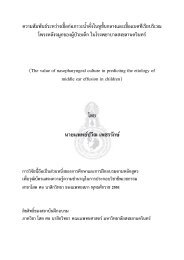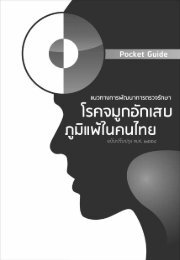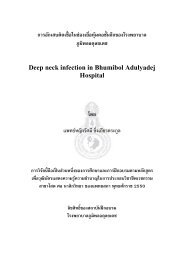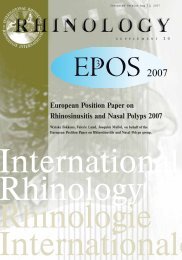Nasal provocation test: how to maximize its clinical use?
Nasal provocation test: how to maximize its clinical use?
Nasal provocation test: how to maximize its clinical use?
You also want an ePaper? Increase the reach of your titles
YUMPU automatically turns print PDFs into web optimized ePapers that Google loves.
Asian Pac J Allergy Immunol 2010;28:225-31Figure 2. Intranasal areanasi and middle meatus.<strong>use</strong>d for <strong>provocation</strong> <strong>test</strong>ing , i.e., anterior end of inferior turbinate, aggeragger nasi area when compared <strong>to</strong> the inferiorturbinate or nasal septum 24 . However, due <strong>to</strong> theease of placing discs on the inferior turbinate, thismethod is recommended by the author. On theother hand, physicians unfamiliar with forcepshandling could make iatrogenic injury <strong>to</strong> theintranasal structures. Due <strong>to</strong> these shortcomings,some researchers prefer other delivery methods.Bottle droppers and micropipette methods areeasy <strong>to</strong> <strong>use</strong> delivery devices. Nonetheless, theymay have some disadvantages since the area inthe nose where the allergen has been applied isnot seen. Moreover, allergen could be aspiratedin<strong>to</strong> the larynx, inducing cough, laryngealirritation, edema or bronchospasm 18 .A better method of delivery could be by usinghand-operated nasal spray. With the spraymethod, a reasonable contact area would be <strong>to</strong> theanterior part of nasal cavities. Beca<strong>use</strong> of ease of<strong>use</strong> and the predictability of the amount ofallergen administered, most of research centers inEurope recommend this method as a standarddelivery system 23 . A<strong>to</strong>mizers also generate largerparticles which help avoiding aspiration ofallergens in<strong>to</strong> the lower airways.Allergen dosageSome investiga<strong>to</strong>rs <strong>use</strong> titration doses butsome <strong>use</strong> one single concentration of allergen forroutine <strong>clinical</strong> NPT 7 . For titration NPT, thelowest allergen concentration should be startedfrom 1:10,000 <strong>to</strong> 1:5,000 w/vol or 50 allergenunit (AU)/ml or 50-100 protein nitrogen unit(PNU) 7,25 . If the initial concentration does notinduce any symp<strong>to</strong>m or <strong>clinical</strong> signs, then thenext concentration is increased by a 3-foldincrement, e.g. 1:10,000, 1: 3,000, 1: 1,000 26 .It should be noted that such recommendeddoses have been applied <strong>to</strong> European subjects.According <strong>to</strong> a study by Roongapinun et al.performed in 44 Thai patients with perennialallergic rhinitis, significant changes in <strong>to</strong>tal nasalsymp<strong>to</strong>m score (TNSS) and nasal airwayresistance (NAR) were observed at theconcentration of500-1,000 AU/ml 27 .The dosage of allergen will also depend on thedelivery technique. For the paper disc technique,Okuda <strong>use</strong>d 3mm diameter disc soaked with 5-500 ug ho<strong>use</strong> dust extract 24 . Schumacher et al.<strong>use</strong>d 4 mm disc with 10 µl dose 28 . We havemodified the Okuda-paper disc method by using5mm disc with a 0.01 ml dose 29 . For the a<strong>to</strong>mizerdosimeter,0.1 ml of allergen per spray is <strong>use</strong>d.The <strong>test</strong> solution is applied in<strong>to</strong> the nose bypointing the device upwards and laterally <strong>to</strong>deposit allergen solution on the middle andinferior turbinates, while avoiding sprayingdirectly <strong>to</strong> the back of the nose 7 . EvaluationFour cardinal symp<strong>to</strong>ms of allergic rhinitis areassessed before and after instillation of allergenextract in<strong>to</strong> the nasal cavity. They are itching,sneezing, rhinorrhea and nasal obstruction.228Downloaded from http://apjai.digitaljournals.org. For personal <strong>use</strong> only. No other <strong>use</strong>s without permission.
















